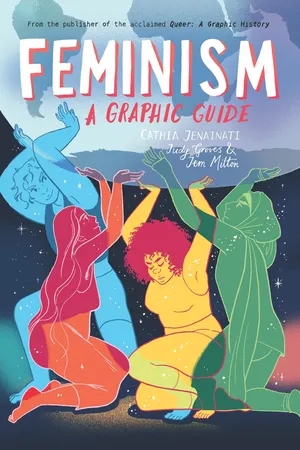
- 192 pages
- English
- ePUB (mobile friendly)
- Available on iOS & Android
Feminism: A Graphic Guide
About this book
What is feminism? Why are we still talking about it, and what can it tell us about ourselves, our societies and prejudices? In this unique, illustrated introduction, we'll explore the early history of conscious struggle against sexist oppression, through the modern "waves" of feminism, up to present-day conversations about MeToo, intersectional feminism, and women's rights in the Middle East. We'll look at critical theory, popular action and the social and cultural forces that affect attitudes toward gender, women's lives and the struggle for equality. And we'll hear about the contributions of pioneers like Mary Wollstonecraft, Simone de Beauvoir and Kimberlé Crenshaw. As we'll see, feminism is at once global, local and individual.Written by Cathia Jenainati with illustrations from Judy Groves and Jem Milton, Feminism: A Graphic Guide engages with the heated debates taking place in our homes, workplaces and public spaces -- and the work still to be done.
Frequently asked questions
- Essential is ideal for learners and professionals who enjoy exploring a wide range of subjects. Access the Essential Library with 800,000+ trusted titles and best-sellers across business, personal growth, and the humanities. Includes unlimited reading time and Standard Read Aloud voice.
- Complete: Perfect for advanced learners and researchers needing full, unrestricted access. Unlock 1.4M+ books across hundreds of subjects, including academic and specialized titles. The Complete Plan also includes advanced features like Premium Read Aloud and Research Assistant.
Please note we cannot support devices running on iOS 13 and Android 7 or earlier. Learn more about using the app.
Information
What is Feminism?

Is Feminism Still Relevant?
- Equal pay
- Equal educational and job opportunities
- Free contraception and abortion on demand
- Free 24-hour nurseries
- Legal and financial independence for all women
- The right to self-defined sexuality and an end to discrimination against lesbians
- Freedom from intimidation by the threat or use of violence or sexual coercion; and an end to the laws, assumptions and institutions which perpetuate male dominance and aggression to women.

What is Patriarchy?

Biology is Destiny
Logic or Emotion?


Early Modern Feminist Activity

Table of contents
- Cover
- Title Page
- Contents
- Copyright
- What is Feminism?
- Is Feminism Still Relevant?
- What is Patriarchy?
- Biology is Destiny
- Logic or Emotion?
- Early Modern Feminist Activity
- Reinterpreting the Bible
- First Political Action
- “To the Ladies”
- Early Perspectives
- The Age of Reason
- Social Planners
- Competing Perspectives
- The Rise of Individualism
- First Wave Feminism
- Remembering the Ladies
- Mary Wollstonecraft
- An Unconventional Life
- Against Rousseau
- Sense and Sensibility
- The Divine Right of Husbands
- The Grimké Sisters
- The “Cult of Domesticity”, 1820-80
- Rules of Conduct for Men and Women
- Harriet Taylor Mill
- Theory and Practice
- A Panoply of Servants
- “Man” or “Person”?
- Caroline Norton
- Coverture
- The Infant Custody Act
- The Matrimonial Causes Act
- Women’s Suffrage in Australia
- Early Feminist Activity in Canada
- Seneca Falls Convention, New York 1848
- A Declaration of Independence
- The Advent of the Bloomers
- The 1850s in the USA
- The International Council of Women
- The 1850s in Britain
- Barbara Bodichon
- Langham Place
- Emmeline Pankhurst
- The Woman’s Social and Political Union
- Militant Suffragettes
- Suffrage Gains Momentum
- Against Suffrage
- The First Backlash
- Feminism = Lesbianism?
- Educated but Under-employed
- The Lost Sex
- Virginia Woolf
- A Room of One’s Own
- Guineas and Locks
- “I have no country …”
- Simone de Beauvoir
- Existence Precedes Essence
- Second Wave Feminism: Milestones
- The Women’s Liberation Movement
- The Personal is Political
- Betty Friedan
- The Feminine Mystique
- Motherhood Before Career?
- Consciousness-raising
- Critiques of Consciousness-raising
- Varieties of Feminisms
- Socialist Feminism
- Traditional Marxist Feminism
- Radical Feminism
- Ecofeminism
- Psychoanalytic Feminism
- Postfeminism
- Protest and Revolt: Beauty Pageants
- Germaine Greer
- Shulamith Firestone
- Reproduction, not Production
- Consuming for Capitalism
- Kate Millett
- The Sex/Gender Hierarchy
- Misogyny in Literature
- Ann Oakley
- Subject Women
- Gynocriticism
- Psychoanalysis and Feminist Thought
- “The Reproduction of Mothering”
- Mermaids and Minotaurs
- Separation from the Mother
- Adrienne Rich
- Gyn/Ecology
- The 1980s
- Black Women’s Experience of Feminism
- Early Expressions of Black Feminism
- A’n’t I a Woman?
- Frances Harper
- The Combahee River Collective
- Black Feminist Activity in Britain
- Gynocentricism and Black Feminism
- bell hooks
- Alice Walker
- Popular Fiction in the 1980s
- The Power of Romance
- Feminism and Pornography
- Feminism and the Body
- The Third Wave
- A Crisis of Victimization?
- Deconstructive Feminism
- Girl Power
- Third Wave Feminism and Pop Culture
- Emerging Concerns
- Feminism and Transgender Identity
- Feminism and Media Activism
- Intersectionality
- Neoliberal Feminism
- Feminist Activity in Developing Countries
- The Subaltern
- Challenging Rituals
- Arab Feminism and Social Media
- The Girl in the Blue Bra
- What is Feminism?
- Milestones
- Further Reading
- About the Author and Artists
- Author’s Acknowledgements
- Index